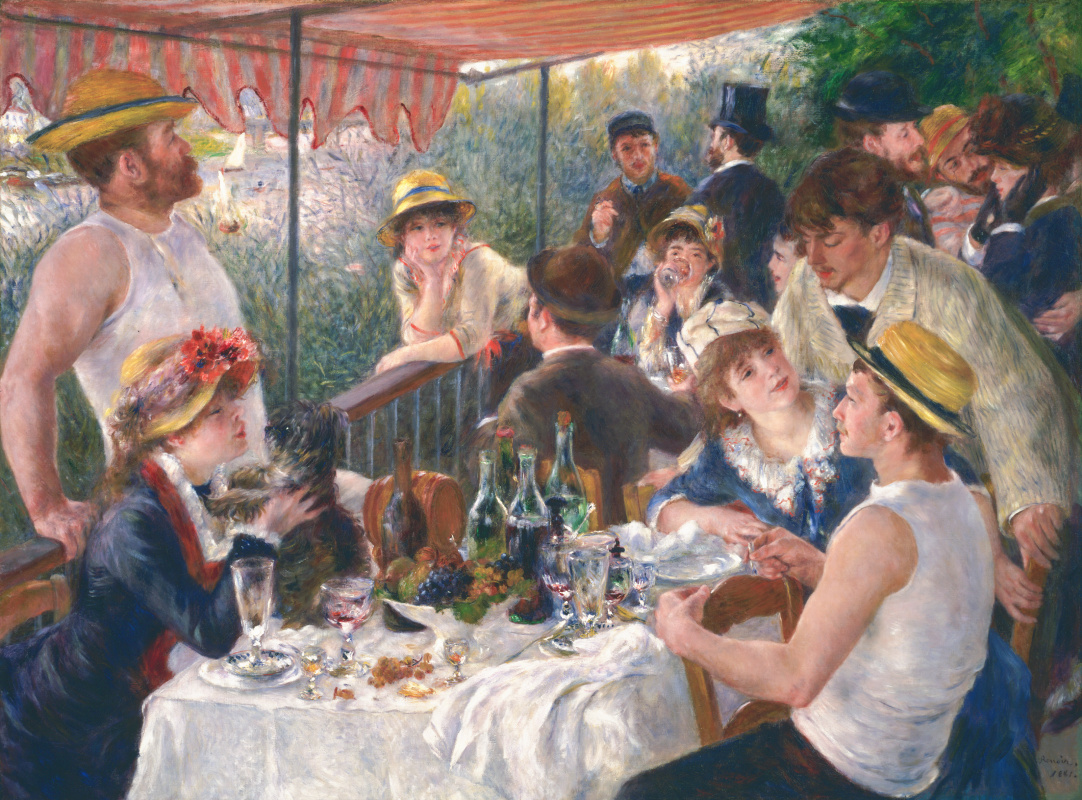log in
Enter site
Login to use Arthive functionality to the maximum
Luncheon of the boating party
Pierre Auguste Renoir • 绘画, 1881, 129.5×172.7 厘米
画作描述 «Luncheon of the boating party»
"Luncheon of the boating party" is emotion, impression and immediacy in its purest form. Renoir loved not to imply anything special, with no plot, no intrigue or story, no deep philosophical subtexts and historical contexts.
Renoir would be very unhappy if he heard that this painting is mentioned in connection with war. IJust a few words about the war. The war had ended 10 years before this piece was finished. France parted with the monarchy and those were the years of desperate poverty, diseases and deep depression when the French started to learn anew how to celebrate. By that time, six Impressionist exhibitions had been held.
By 1881 Paris was flooded with a wave of creative excitement and optimism, life became easy and real. Cafes, concerts, cabaret, fashionable yachts-clubs, theaters, restaurants, fashion salons, circuses. At the same time, working week was reduced, and factory workers, porters, market vendors, butchers, barbers were getting more free time – they often danced and sang. Until then, the only activity for the poor was a ball, and for the rich – horse riding, but suddenly sailing became the most fashionable and fun entertainment.
The restaurant of the Fournaise family was all-in-one: a hotel, yacht club and beloved place in the suburbs of Paris for young artists and writers to meet. In summers, Renoir lived in the town of Chatou and invited friends to dine with him on the day off to pose for a new picture. Aline Charigo, the future wife of the artist, is playing with the dog, Gustave Caillebotte in a straw hat on the chair is smoking, Jeanne Samari straightens her bonnet talking to the art critic Charles Ephrussi. Alphonsine Fournaise, the daughter of the owner, is leaning on the patio railing, and the Monsieur Fournaise, a muscular bearded man in a straw hat, is peering into the distance. They were all in Chatou at different times and all patiently posed for Renoir in the desired position.
Today, the restaurant "Maison Fournaise" looks exactly the same as in the days of the artist, and the terrace, where the rest the subjects of his "Luncheon" is called "Renoir". The restaurant's terrace to honor him: Renoir would be happy.
Author: Anna Sidelnikova
Renoir would be very unhappy if he heard that this painting is mentioned in connection with war. IJust a few words about the war. The war had ended 10 years before this piece was finished. France parted with the monarchy and those were the years of desperate poverty, diseases and deep depression when the French started to learn anew how to celebrate. By that time, six Impressionist exhibitions had been held.
By 1881 Paris was flooded with a wave of creative excitement and optimism, life became easy and real. Cafes, concerts, cabaret, fashionable yachts-clubs, theaters, restaurants, fashion salons, circuses. At the same time, working week was reduced, and factory workers, porters, market vendors, butchers, barbers were getting more free time – they often danced and sang. Until then, the only activity for the poor was a ball, and for the rich – horse riding, but suddenly sailing became the most fashionable and fun entertainment.
The restaurant of the Fournaise family was all-in-one: a hotel, yacht club and beloved place in the suburbs of Paris for young artists and writers to meet. In summers, Renoir lived in the town of Chatou and invited friends to dine with him on the day off to pose for a new picture. Aline Charigo, the future wife of the artist, is playing with the dog, Gustave Caillebotte in a straw hat on the chair is smoking, Jeanne Samari straightens her bonnet talking to the art critic Charles Ephrussi. Alphonsine Fournaise, the daughter of the owner, is leaning on the patio railing, and the Monsieur Fournaise, a muscular bearded man in a straw hat, is peering into the distance. They were all in Chatou at different times and all patiently posed for Renoir in the desired position.
Today, the restaurant "Maison Fournaise" looks exactly the same as in the days of the artist, and the terrace, where the rest the subjects of his "Luncheon" is called "Renoir". The restaurant's terrace to honor him: Renoir would be happy.
Author: Anna Sidelnikova




